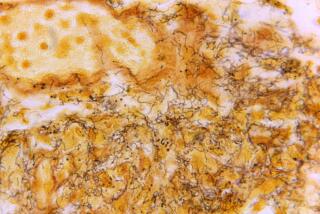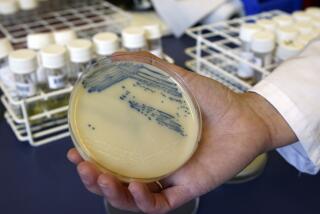‘Superbug’ infections drop for procedure
- Share via
Bloodstream infections caused by methicillin-resistant Staphylococcus aureus, or MRSA, have dropped 50% in the last decade, at least for one high-risk medical procedure, according to a new study.
The finding, although limited to a single procedure in the intensive-care units of hospitals surveyed -- insertion of a central line, or catheter, into a major blood vessel -- runs contrary to the widespread perception of MRSA as an out-of-control hospital superbug.
“This study shows that at least in one facet of healthcare-associated infections, things seem to be moving in the right direction, and that’s a good thing for patient safety,” said study coauthor Dr. John Jernigan, an epidemiologist at the national Centers for Disease Control and Prevention. “Are we all the way there yet? No.”
The finding was published today in the Journal of the American Medical Assn.
MRSA catapulted to the general public’s attention two years ago when infectious disease experts estimated that the antibiotic-resistant bacterium causes 19,000 deaths a year and that 85% of the infections are contracted in healthcare settings such as nursing homes, dialysis centers and hospitals.
Many states, California among them, have passed laws since then aimed at stopping MRSA and other healthcare-associated infections, prodded by patient safety advocates. Such measures include screening patients on admission for the bacterium, isolating those found to be infected and publicly posting hospital infection rates.
Hospital and physician groups have generally opposed such laws as neither cost-effective nor scientifically proven.
The authors of the new study, all CDC researchers, said that the decline in central line-associated infections was underway before such laws were passed.
A central line is a catheter, or tube, inserted into one of the main blood vessels close to the heart. It is used to administer medications and monitor blood and heart pressures. Inserting this and other devices, such as urinary catheters or ventilator tubes, puncture the skin’s protective barrier and allow microbes that may be harmless on the outside into areas where they can cause harm.
The new study was drawn from data on central-line bloodstream infections reported voluntarily to the CDC from more than 1,600 intensive care units.
“There’s this perception that there’s a big cover-up and hospitals aren’t addressing these issues as aggressively as need be,” said Dr. Mark Rupp, president of the Society of Healthcare Epidemiology of America, who was not associated with the study. “This study would indicate that people have been working on these problems and having a big effect for some time now.”
Lisa McGiffert, who directs the Stop Hospital Infections project for Consumers Union, which supports legislation, said, “This shows us that we really can have an impact on these infections that for so long have been treated as inevitable. Passing legislation has been a major factor in generating attention to the problem and putting pressure on hospitals to do something about it.”
The study looked only at the number of infections, not at practices that may have contributed to the decline, so researchers cannot say what led to the drop in MRSA infections.
The issue is difficult, scientists said, because studies have reached conflicting conclusions on how to best control the spread of hospital-acquired infections.
In 2008, for example, a paper published in the Journal of the American Medical Assn. concluded that screening surgical patients for MRSA wasn’t particularly effective at reducing infections.
One week later, another study published in the Annals of Internal Medicine reported that aggressively screening all patients and isolating those with bacteria was effective.
About 1 in 3 people carries some variety of the bacterium Staphylococcus aureus in the nose or skin, usually without harm. The antibiotic-resistant strain MRSA first emerged in hospitals in the 1960s.
In the last decade, a new, more virulent strain of MRSA has emerged outside of hospitals, causing an explosion in rates of severe skin infections. First identified in 2000 and named USA 300, the community-acquired strain isn’t the same bacterium that strikes patients in hospitals.
--






